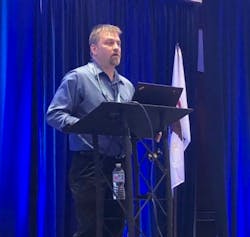This article originally appeared May 14, 2019.
For car manufacturer Subaru, quality is the priority. And at Subaru of Indiana Automotive, the home of North American production for the Ascent, Impreza, Legacy and Outback models, there’s a 24-day turnaround time from time-to-order to the consumer.
“We are the only Subaru plant outside of Asia, so we have a large responsibility to keep uptime and quality up in our plant,” said Trent Lester, group leader of Central Control Room (CCR) Systems at Subaru of Indiana.
They seem to be doing a good job, as Subaru production volume is up 300 percent since 2006. But there are new industry trends, including electric vehicles, autonomous driving, as well as environmental regulations and ever-changing consumer demands, that will add more complexity into operations, which is why Subaru is moving toward more smart manufacturing technologies in order to keep up with growth.
“We need to make sure to get the customer what they want with efficiency and quality,” said Lester, who was speaking at The Automation World Conference & Expo this week in Chicago.
To keep up with demand and quality assurance, Subaru of Indiana is relying upon the real-time data generated by GE Digital’s iFix HMI/SCADA software, which is used for plantwide monitoring and control.
As each car goes down the production line, everything that goes into the car is monitored and the data is collected and kept, so if there were ever a problem with brakes six months down the road, for example, they can look at the data to know all the details that went into the brakes in the car. But beyond having a historical record, the software tracks the vehicle as it moves through production. Simply by typing in the vehicle number, operators can see exactly where a car is in the plant.
That’s important given the size of the facility and the volume of product moving through. For example, there are over 1,000 robots in the body assembly section of the plant, people on the floor manage daily production and respond to faults, but they don’t always see where the main issues are. Using iFIX to monitor the performance of the robots, operators get information that can then be directed to engineering and maintenance departments, when needed.
Similarly, the paint shop has about 1,400 different motors pushing the cars on a conveyor system through the facility. Using remote management capabilities of GE Digital software, maintenance technicians can see all of the motors and quickly identify if there’s a problem.
“Subaru has 17 miles of conveyors,” Lester said. “That means there’s a lot of motors and different routes the cars can take. We need to make sure the cars are going in the proper direction at all times.”
An Eye on HMI
Of course, getting the right data to the right person at the right time is important.
“The heart and soul of the GE platform is the tag database…that connects to machinery on the floor,” Lester said. “The GE interface can see alarms happening, like if an oven temperature is down. But the best part of this, in our eyes, is that we are able to write custom code to interface with that tag database. By interfacing with that we can write programs that can make smart decisions for the operators, so the operator doesn’t always have to watch what’s going on, we can help make decisions for them.”
While there’s a lot of information on the human machine interface (HMI) screen, there are colored blocks that help operators track the car. And, with a click on the block, they can see exactly what car it is, what color it will be painted and what time it entered and exited the booth. Along the same lines, there’s a complete overlay of all the areas that enables the car to be followed through the entire painting production flow.
“If we can control where things are and how they are flowing through the process that enables us to control the quality,” Lester said. It also provides really good information for making decisions. At the top of the HMI screen is an alarm bar with the alarms going off that need to be resolved. “It’s just something for the operator to use as a quick reference of what they need to do.”
There are also visual boards placed around the plant that, if an area is lit up yellow, indicate an issue in a station. It is a quick and intuitive reference.
So, what’s next?
“We’ve done good job of keeping production volume up and quality at a high level. And, as we grow, we see a need for more automation for operators to help with decision-making,” Lester said, noting that the company will be upgrading to the latest version of iFix, as well as moving to the Predix manufacturing execution system (MES). “We want to get to the point of predictive maintenance. We want to be proactive instead of reactive on downtime. Our goal is no downtime.”

